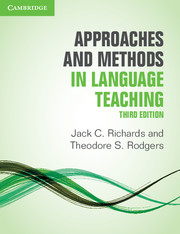Book contents
- Frontmatter
- Contents
- Acknowledgments
- Introduction to the third edition
- I Major trends in twentieth-century language teaching
- II Current approaches and methods
- III Alternative twentieth-century approaches and methods
- IV The teaching and learning environment
- Appendix: Comparison of approaches and methods
- Author index
- Subject index
II - Current approaches and methods
Published online by Cambridge University Press: 08 April 2022
- Frontmatter
- Contents
- Acknowledgments
- Introduction to the third edition
- I Major trends in twentieth-century language teaching
- II Current approaches and methods
- III Alternative twentieth-century approaches and methods
- IV The teaching and learning environment
- Appendix: Comparison of approaches and methods
- Author index
- Subject index
Summary
The chapters in Part II bring the description of approaches and methods up to the present time and describe some of the directions mainstream language teaching has followed since the emergence of communicative methodologies in the 1980s.
Communicative Language Teaching (CLT), which we examine in Chapter 5, marks the beginning of a major paradigm shift within language teaching in the twentieth century, one whose ramifications continue to be felt today. The general principles of CLT are still widely accepted in language teaching today, although as we demonstrate in this chapter, these principles have been open to various interpretations, and those favoring the approach may weigh the value of fluency and accuracy in different ways. Aspects of CLT may also be used to support other approaches and methods. In Chapter 6, we consider Content-Based Instruction (CBI) and Content and Language Integrated Learning (CLIL). The first (CBI) can be regarded as a logical development of some of the core principles of CLT, particu-larly those that relate to the role of meaning in language learning. Because CBI provides an approach that is particularly suited to prepare ESL students to enter elementary, secondary, or tertiary education, it is widely used in English-speaking countries around the world, particularly in the United States. CLIL, a related approach, has become popular in Europe; both approaches involve a merging of content and language. In Chapter 7, we look at the Whole Language movement that developed in the 1980s as a response to teaching the lan-guage arts. As an approach aimed at younger learners, it may be contrasted with the more modern-day CBI and CLIL.
Chapters 8 through 11 examine, like CBI, CLIL, and Whole Language, a number of other special-purpose approaches, in the sense that they have specific goals in mind or reflect principles of language learning that have a more limited application. In Chapter 8, we describe Competency-Based Language Teaching (CBLT), standards, and the Common European Framework of Reference (CEFR), all reflecting the outcomes movement that has become increasingly important in recent years as programs strive for accountability and a focus on standards in teaching and learning. In Chapter 9, we look at Task-Based Language Teaching (TBLT), an approach that aims to replace a conventional language-focused syl-labus with one organized around communicative tasks as units of teaching and learning.
Information
- Type
- Chapter
- Information
- Approaches and Methods in Language Teaching , pp. 81 - 82Publisher: Cambridge University PressPrint publication year: 2014
